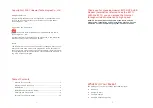
44
MultiModemBA User Guide
4.4.11
Speed Conversion Commands
Speed conversion is a necessary part of data compression since data must be presented to the
modem faster than it can handle data, if data compression is to be effective.
Speed conversion allows the modem to communicate at one speed over the phone line, and at
another speed at the RS-232C interface. The speed (also referred to as
“data rate” or “baud rate”)
can be fixed at the RS-232 interface independently of the baud rate of the on-line transmissions.
In addition to data compression, another popular application for speed conversion involves an auto-
answer MultiModem connected to a computer that does not have autobaud capability. This means
that the computer must be set at a fixed baud rate, regardless of the baud rate that the modem is
communicating over the phone line at. In this application, speed conversion allows the modem to
match its speed to that of the calling modem, while at the same time communicating with the
attached computer through its RS-232C port at a fixed baud rate, which can be pre-selected at 300,
1200, 2400, 4800, 9600, 19,200, 38,400, 57,600 bps or 115,200 bps.
Speed Conversion $BA
When using speed conversion, you must set the modem so that it does not adjust its speed at the
RS-232C serial port, even if the modem does adjust its data rate. To turn Speed Conversion ON,
enter the command
AT$BA0 and hit RETURN.
To turn Speed Conversion OFF, enter
AT$BA1 and hit RETURN. The modem will now match its RS-
232C speed to that of the computer, and will adjust its speed to any changes in the computer’s speed
in Originate mode, or to the speed of the originating modem in Answer mode. The speed at which the
modem communicates over the phone line will always be the same as the speed at which it
communicates via its RS-232C serial port.
Modem Baud Rate $MB
The
$MB command presets the modem’s transmission baud rate for originate operations, (i.e., the
speed of the modem’s transmissions over the telephone lines when originating a call). With speed
conversion, this transmission speed can be a different baud rate than the serial port speed.
When the modem receives (answers) a call from another modem, it automatically switches its phone
line transmission speed to match the calling modem. However, if the modem originates a call to
another modem that is unable to connect at the same baud rate, it automatically drops to a lower
baud rate in an attempt to match the speed of that modem. For example, if the modem is set for
14,400 baud and calls another modem that has a top speed of 2400 baud, it drops to 2400 baud.
The command to set the Modem Baud Rate is
AT$MBn, where n can be:
AT$MB75
=
CCITT V.23
AT$MB300
=
300 bps
AT$MB1200
=
1200 bps
AT$MB2400
=
2400 bps
AT$MB4800
=
4800 bps
AT$MB9600
=
9600 bps
AT$MB14400
=
14400 bps
AT$MB19200
=
19200 bps
AT$MB28800
=
28800 bps
AT$MB33600
=
33600 bps
The factory default is 33600 bps.
Summary of Contents for BA-Series
Page 1: ...BA Series Intelligent Data Fax Modem User Guide ...
Page 5: ...Chapter 1 Introduction and Description ...
Page 13: ...Chapter 2 Installation and Connection ...
Page 17: ...Chapter 3 Software Configuration and Modem Basics ...
Page 21: ...Chapter 4 Command Mode ...
Page 49: ...Chapter 5 S Registers ...
Page 57: ...Chapter 6 Callback Security and Remote Configuration ...
Page 65: ...Chapter 7 DIP Switch Settings ...
Page 74: ...Chapter 8 Warranty Service and Tech Support ...
Page 78: ...Appendixes ...
















































